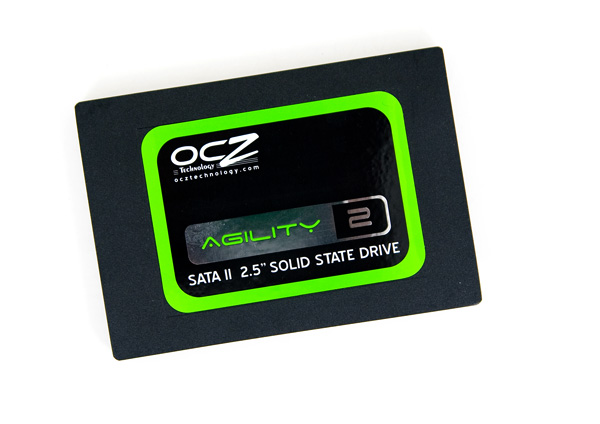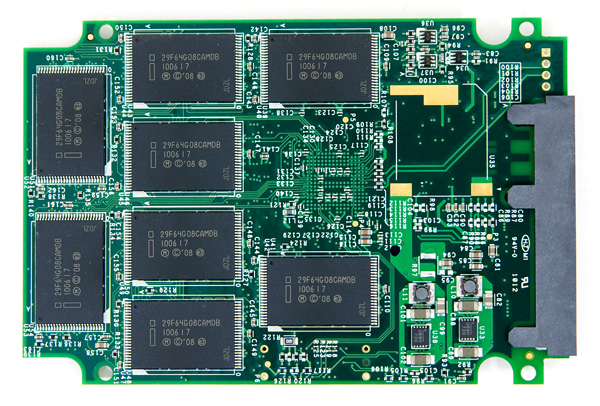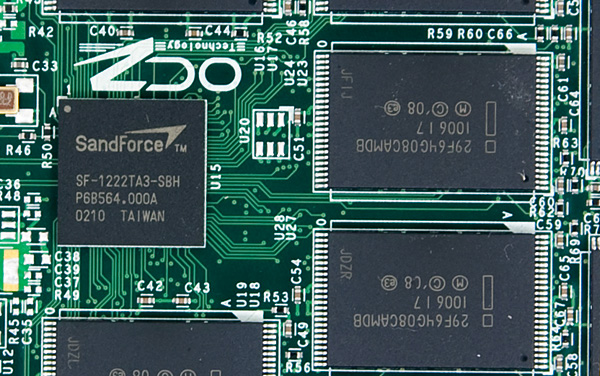OCZ's Agility 2 Reviewed: The First SF-1200 with MP Firmware
by Anand Lal Shimpi on April 21, 2010 7:22 PM ESTOCZ's Agility 2 and the SF-1200
Relegating Indilinx to the bottom of the pyramid for now is a bold move for OCZ. Considering how much business OCZ has given Indilinx over the past year I don’t expect that they are very happy over this move.
SandForce’s architecture is on a different level from what we’ve seen from Indilinx. While the Vertex could be viewed as an Intel alternative, OCZ’s Vertex 2 and Agility 2 are designed to offer better-than-Intel performance and as such they actually command a higher dollar-per-GB rate.

Both the Vertex 2 and Agility 2 are based on SandForce’s SF-1200 controller. I’ve described the differences between this and the SF-1500 in detail here. It boils down to a bunch of enterprise class features missing and lower sustained small file random write speed on the SF-1200 vs. the 1500.
The Vertex 2 retains the small file random write performance of the SF-1500, while the Agility 2 is a standard SF-1200 implementation. According to SandForce, the Agility 2 is representative of how all other SF-1200 based SSDs will perform using the 1200’s current mass production firmware (more on this later).


Note the missing super cap, that's a feature of enterprise SF-1500 designs
OCZ sent in their Agility 2 for review, arguably the more interesting of the two since we already have an idea of how the Vertex 2 will perform. Similar to previous Agility drives, the new A2 shaves a small amount off the retail price of the Vertex 2 in exchange for lower performance:
| OCZ SandForce Drive Pricing (MSRP) | |||||
| 50GB | 100GB | 200GB | |||
| OCZ Agility 2 | $204.99 | $379.99 | $719.99 | ||
| OCZ Vertex 2 | $219.99 | $399.99 | $769.99 | ||
The Agility 2 ships with a 2.5" to 3.5" drive sled for use in desktops. If you use this sled the SATA ports won't line up with drive trays in systems like the Mac Pro.
Inside the drive itself we find SandForce’s SF-1200 controller and no external DRAM. SandForce’s architecture attempts to solve the issue of NAND write amplification by simply writing less to the drive through compression/deduplication techniques. With less data to keep track of, a large external DRAM isn’t necessary - assuming the data being written is easily reduced by SandForce’s algorithms.
SandForce also claims that its reduced write amplification could enable the use of cheaper NAND on these drives. It’s an option that some manufacturers may take however OCZ has committed to using the same quality of NAND as it has in the past. The Agility 2 uses 34nm IMFT NAND, presumably similar to what’s used in Intel’s X25-M G2.

The Agility 2 sample OCZ sent had the first SF-1200 mass production firmware (v3.0.5) from SandForce on it with full TRIM support. The Agility 2 should begin shipping to etailers later this month.










60 Comments
View All Comments
beginner99 - Friday, April 23, 2010 - link
One thought:Wouldn't it be possible just tp use the vertex 2 "special" firmware for tis drive? I mean as far as i understood the controllers are 100% identical it is the firmware that makes the difference. Same should be true for any SF-1200 drive.
But i'm not gonna try it out myself. ;)
Moonstarr - Sunday, May 9, 2010 - link
Exactly what I was thinking. Take a look at the photos in the gallery and you'll see that the board revisions and controller are identical. Only the branding of the ram looks different.jordanl17 - Saturday, April 24, 2010 - link
Does anyone use these SSDs in a server? Image a 7 drive raid-5 array ?!?!? it would be great. (I'm talking about for a Terminal Server 2008 64bit. all new hardware)I'd like to buy either an HP or IBM blade setup and use 2 of these drives in raid-1 in each blade.
Does anyone know if this is possible? I know it wouldn't be as reliable as regular hard drive, but I'd keep a few on hand as backup.
charlielittle - Saturday, April 24, 2010 - link
I'm using a 128gb NOVA in a Dell D820 with WinXP. I'd like to keep its great performance up to snuff without doing a full wipe. I was wondering, would it be possible to plug it in as an extra drive on my Win7 desktop and run some utility to force TRIM commands for any/all unused blocks on the drive? Does it have to be the boot drive for TRIM to be enabled by Win7?Thanks,
--C
iwodo - Sunday, April 25, 2010 - link
While Sandforce was slower in Seq Read / Write with Random Data. Would the setting have any different on other non Sandforce SSD.pesos - Sunday, April 25, 2010 - link
it would be awesome if a SAS 15k drive could be thrown into these SSD benchmarks going forward for those of us interested in doing enterprise comparisons!remmelt - Monday, April 26, 2010 - link
The SSDnow V+ second generation doesn't perform all that well in the individual tests, but scores remarkably well in the overall performance graphs. Considering price per GB, this might be a great alternative.Can anyone explain the difference in the low scores on individual tasks and high scores in the overal benchmarks for this drive?
Squuiid - Monday, April 26, 2010 - link
Anand, excellent review as always, thanks very much.Any updates on your Crucial drive? Are you now confident recommending the drive? Has the new one they sent you been reliable and has the performance degradation now been fixed?
Sorry for the million questions.
brain42 - Wednesday, April 28, 2010 - link
I notice that the latest drives have much higher random write performance than the random read performance, even though the typical scenario has more reads than writes.Could this be a symptom that the SSD industry is becoming so focused on random write, that the random read performance is forgotten? When all the reviewers focus solely on the random write performance, you can't really blame the industry for sacrificing performance in other areas.
fishak - Wednesday, April 28, 2010 - link
remmelt, that is my question exactly. Why is the PC Mark score of the Intel G2 controller, so close to Sandforce, while the individual read and write scores of the Intel controller are so far behind?Per GB price of Intel is about $3.50, while Sandforce is about 4 bucks.